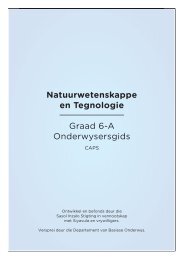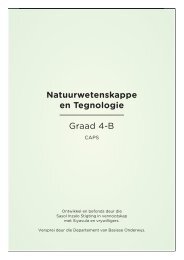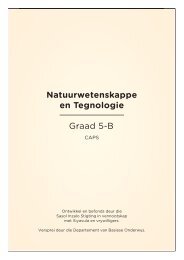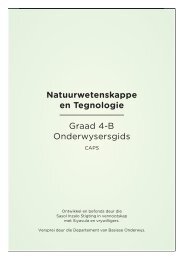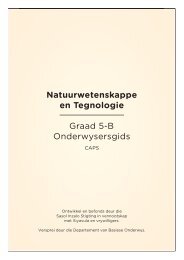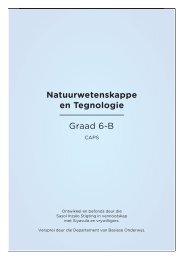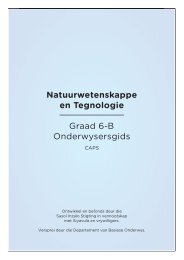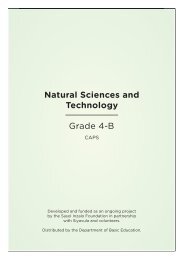Natural Sciences and Technology Grade 6-A - Thunderbolt Kids
Natural Sciences and Technology Grade 6-A - Thunderbolt Kids
Natural Sciences and Technology Grade 6-A - Thunderbolt Kids
Create successful ePaper yourself
Turn your PDF publications into a flip-book with our unique Google optimized e-Paper software.
1 Solids, liquids <strong>and</strong> gases<br />
NEW WORDS<br />
• state (of<br />
matter)<br />
• particle<br />
• vacuum<br />
104<br />
KEY QUESTIONS<br />
• How are the 3states of matter dierent from each other?<br />
• How can we draw pictures of the 3 dierent states of<br />
matter, that show how the particles in the matter behave?<br />
• When matter changes from one state to another, do the<br />
particles themselves change, or only their behaviour?<br />
• What is needed to make matter change from one state to<br />
another <strong>and</strong> back again?<br />
1.1 Arrangement of particles<br />
We have learnt that matter can exist in 3dierent states: solids,<br />
liquids <strong>and</strong> gases. All the materials around us are in one or more of<br />
these three states. For example, you have all three states in your<br />
body! There is bone in your skeleton. There is water in your blood.<br />
There is air in your lungs. We have also learnt that each of the<br />
states (solids, liquids <strong>and</strong> gases) has unique properties:<br />
• Solids keep their shape.<br />
• Liquids flow <strong>and</strong> take the shape of their container. They fill up<br />
a container from the bottom up to a certain level. They take<br />
up a fixed amount of space in the container.<br />
• Gases also flow <strong>and</strong> take the shape of their container. They<br />
always fill up the whole space of the container <strong>and</strong> will escape<br />
if the container is open.<br />
We know when we have a solid or aliquid. It is easy to see asolid<br />
or aliquid. We cannot normally see gases. We can still check that<br />
gases are present by seeing their eects.<br />
Why do solids keep their shape but liquids <strong>and</strong> gases flow? Why<br />
does aliquid stay inside an open container (unless it is poured<br />
out), but agas escapes?<br />
We have to look deep inside each state for the answers to these<br />
questions. We will have to use our imaginations like never before!



